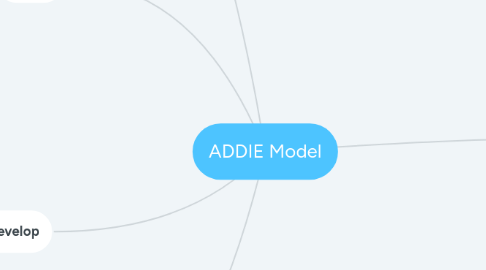
1. Analyze
1.1. In this phase we define the learning outcomes, the instructional goals and objectives, assess the learning environment and check the learner's existing knowledge and skills.
1.1.1. A Needs Analysis consists of 4 Steps.
1.1.1.1. 1. Instructional Goals: what do we want to achieve? In clear, specific outcomes?
1.1.1.2. 2. Instructional Analysis: what steps are necessary, what techniques & tools will work best, what sub-sets of knowledge builds towards our goal?
1.1.1.3. 3. Learner Analysis: what do learners already know, and how can we build on that? At what level do we pitch this? How many learners are at a similar level? Do learners have different needs and expectations?
1.1.1.4. 4. Learner Outcomes: When students are assessed on the training outcomes how will they: Describe, Demonstrate, Show and Explain their experience and learning?
2. Design
2.1. In this phase we set the learning objectives, plan the lessons, select the assessment instruments, decide on content, activities, the role of subject-matter-experts and modes of media to be used.
2.1.1. In designing the learning delivery we...
2.1.1.1. 1. Decide how success will be assessed - we begin with the end in mind
2.1.1.2. 2. Select our course format - tools, media, activities that will achieve the desired impact.
2.1.1.3. 3. Create our Instructional Strategy - through Pre-instructional activities, Content Presentation, Learner Participation, Assessment, and Follow-Through Activities.
3. Develop
3.1. Develop and create the actual content - written, graphics, storyboards, media and technology is integrated.
3.1.1. 1. Develop Course materials - how are lesson plans created? What activities are integrated? What examples help internalisation? How is media used? How is positive feedback loop built into the process?
3.1.2. 2. Rehearsals and Dry-Runs... the more you practice the better you get, test, re-test, drive your colleagues and friends crazy.
4. Implement
4.1. Final Preparation, Training of Facilitators, Testing of Media & Back Up plans.... Deliver
4.1.1. 2. Think about how this specific cohort of learners is motivated, how learning relates to their lived experiences
4.1.2. 1. Verify Prerequisite training completed; Ensure participants receive all information on time, place and expectations well ahead of time.
4.1.3. 4 Review media back-up contingencies, ensure adequate materials and shape learning environment to best suit learning process.
4.1.4. 3. Remember to summarise learning objectives before and after each lesson; and plan ahead for ideal time management.
5. Evaluate
5.1. Circle back to Analysis phase and review objectives, keep iterating throughout the ADDIE process.
5.1.1. 3. Summative Evaluation - Prove the worth of the instruction - Reaction (survey, Liekert-scale); Learning (test knowledge, performance, attitude); Behaviour (connect theoretical with physical); Results
5.1.2. 2. Formative Evaluation - 1to1, Small group, Field Trial - Clarity, Impact, Feasibility, Interesting, Applicable and Relevant?
5.1.3. 1. Utilise Kirkpatrick's 4-Level Model of Evaluation - positive reaction, skills learnt, behaviour change and positive impact on organisation?

